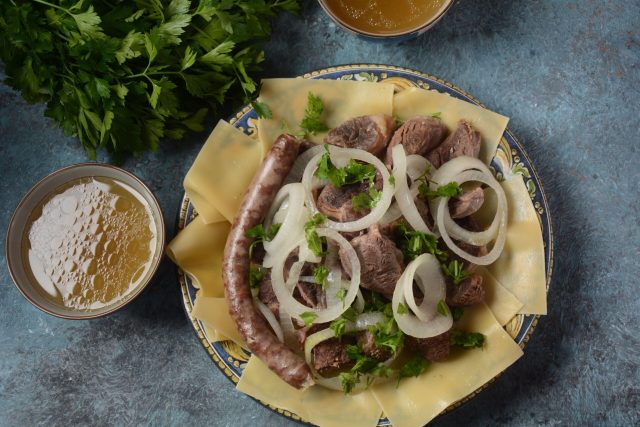Discover Kazakhstan: Beshbarmak – one dish, many stories
Published: by .

Physicists once debated whether an outside observer could understand the structure of the universe based on just a single atom. The answer to this question would be something like this: a great deal, if not everything, about our cosmos can be understood based on a single atom.

Beshbarmak is a national Kazakh dish made with meat and pasta. Beshbarmak dish close-up on a plate on the table. Photo by Alamy
The same goes for Beshbarmak. Just as we see the reflection of the world around us in a drop of water, we can observe the different facets of the nomadic way of life in this single national dish.
Beshbarmak (or besparmak) is a word of Turkic origin, meaning "five fingers". It refers to eating with your hands, without spoons, forks and knives. However, in 2003, the Department for the Development of the State Language in Astana refused to register a restaurant called "Beshbarmachnaya" (roughly "House of Beshbarmak"). There was even a court case where several invited philologists and doctors of science argued that the word beshbarmak is not Kazakh, but a foreign loanword. Thus, they suggested that it is inappropriate to use it as a proper name to refer to a traditional Kazakh dish. Instead, it should be called et asy (meat treats) or simply et (meat). Despite its controversial name, we use "Beshbarmak" here, as it speaks to a broader pan-Turkic and ancient Asian culinary heritage.
Main ingredients
Traditionally, Beshbarmak was a luxury item for nomads, reserved for special occasions. The ingredients reflect this. The wheat for the dough had to be bought and transported, unlike meat and milk, which were readily available in the steppe. The dish also required a cauldron, a rare and valuable item that was often passed down from generation to generation.
1. Meat (Et) : Horse meat is traditional, although lamb and sausages such as kazi and shuzhik are also popular today .
2. Dough (Jaima) : a dough made from wheat flour, often with eggs, rolled out thinly and cooked.
3. Broth (Sorpa) : Strained meat broth used to season a dish.
4. Dressing (Tuzdyk) : herbs stewed in broth, traditionally wild chives, now often replaced with onions and garlic.
5. Curd : a salty, dried cheese, important for digesting large amounts of meat.
Beshbarmak ritual
Beshbarmak is more than a dish; it is a ceremonial experience. Tea accompanies the food, and young children often pour it. Guests are seated together, with a hierarchy reflected in the distribution of meat. The eldest or most honored guest sits at the tor, the highest seat at the table.

A traditional Kazakh family says “Blagodat” at a picnic in the Chilik Sati River Valley, Kazakhstan. Photo credit: Alamy
The meat, carved by the young men, is served in various dishes, such as a bas tabak (large plate) for the older guests and a kiz tabak (a plate for unmarried girls). Each portion has a specific meaning. The host blesses the feast, and the meal unfolds with conversation and shared enjoyment, often lasting for hours.
In modern Kazakhstan, the tradition of Beshbarmak has survived. Whether in rural yurts or city homes, families keep the right cuts of meat ready for unexpected guests.
Basic Beshbarmak recipe
Start by cooking raw meat (horse meat, lamb or both) in cold water over low heat for three to four hours. 30 minutes before the end of cooking, add dried or smoked meat and sausages (kazy, shuzhik). For the dough, mix 200 grams of wheat flour with one egg and three to four grams of salt. If desired, add pumpkin puree for color. Roll out the dough thinly and boil in the broth for two minutes. Cut the jusai (wild onion) or onion into rings, add a little broth and cook for about two minutes. Add grated kurt (dried salty cheese) to the mixture. Put the finished dough on a plate, put the meat on top, pour it with tuzdyk. Serve with shorpa in small jugs or cups, adding grated kurt to the broth if desired.

Asian Kazakh national dish beshbarmak. Photo by Olga Kriger/Alamy
Bon appetit or, as we say in Kazakhstan, bon appetit!
Comments